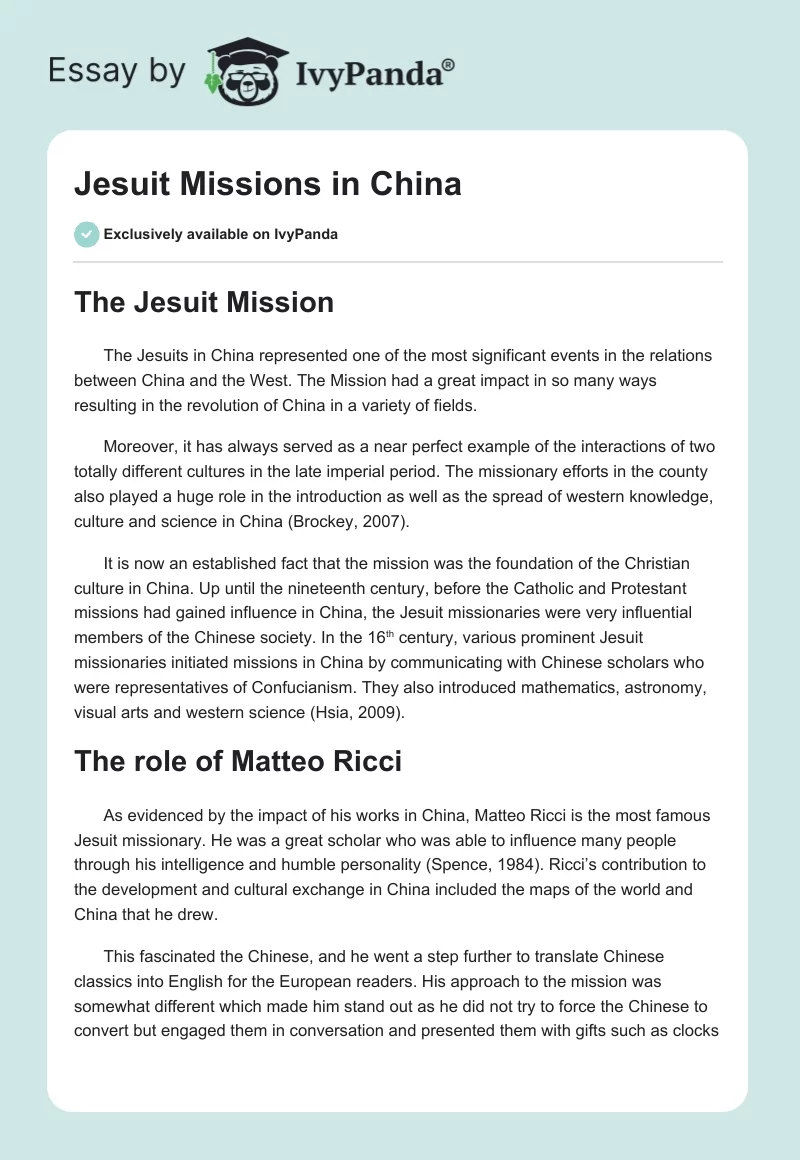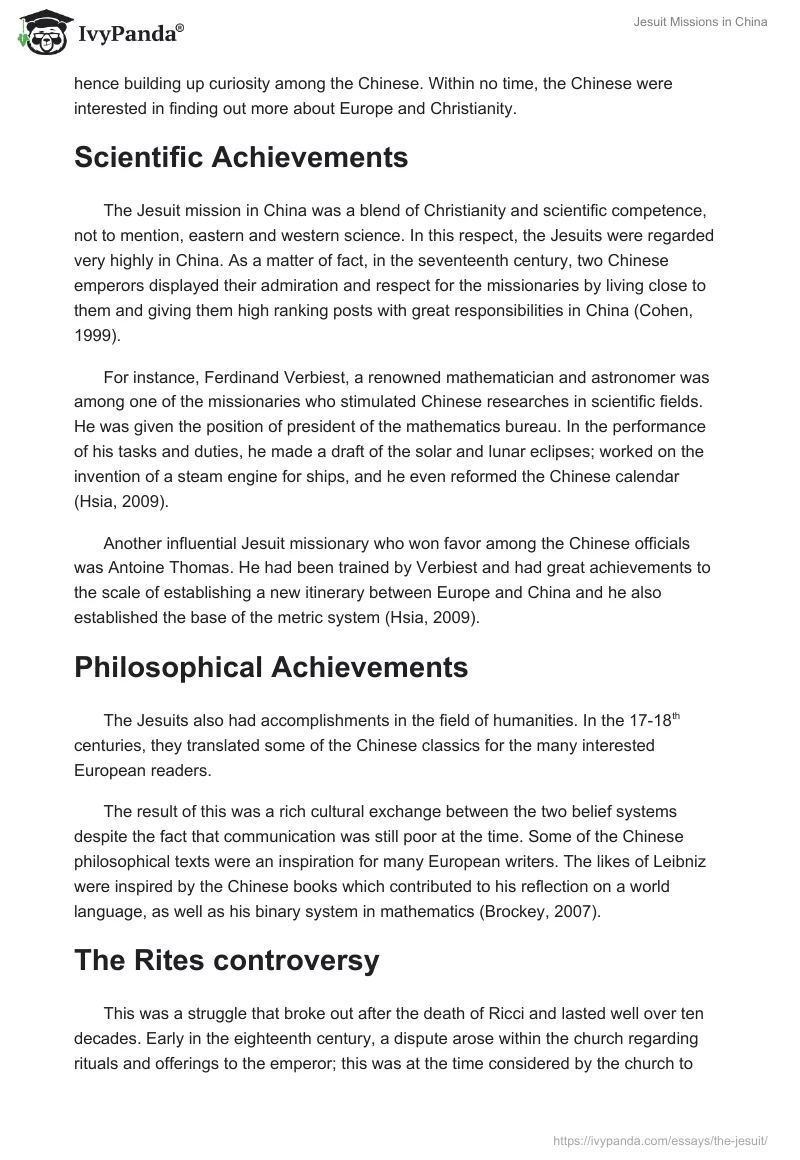The Jesuit Mission
The Jesuits in China represented one of the most significant events in the relations between China and the West. The Mission had a great impact in so many ways resulting in the revolution of China in a variety of fields.
Moreover, it has always served as a near perfect example of the interactions of two totally different cultures in the late imperial period. The missionary efforts in the county also played a huge role in the introduction as well as the spread of western knowledge, culture and science in China (Brockey, 2007).
It is now an established fact that the mission was the foundation of the Christian culture in China. Up until the nineteenth century, before the Catholic and Protestant missions had gained influence in China, the Jesuit missionaries were very influential members of the Chinese society. In the 16th century, various prominent Jesuit missionaries initiated missions in China by communicating with Chinese scholars who were representatives of Confucianism. They also introduced mathematics, astronomy, visual arts and western science (Hsia, 2009).
The role of Matteo Ricci
As evidenced by the impact of his works in China, Matteo Ricci is the most famous Jesuit missionary. He was a great scholar who was able to influence many people through his intelligence and humble personality (Spence, 1984). Ricci’s contribution to the development and cultural exchange in China included the maps of the world and China that he drew.
This fascinated the Chinese, and he went a step further to translate Chinese classics into English for the European readers. His approach to the mission was somewhat different which made him stand out as he did not try to force the Chinese to convert but engaged them in conversation and presented them with gifts such as clocks hence building up curiosity among the Chinese. Within no time, the Chinese were interested in finding out more about Europe and Christianity.
Scientific Achievements
The Jesuit mission in China was a blend of Christianity and scientific competence, not to mention, eastern and western science. In this respect, the Jesuits were regarded very highly in China. As a matter of fact, in the seventeenth century, two Chinese emperors displayed their admiration and respect for the missionaries by living close to them and giving them high ranking posts with great responsibilities in China (Cohen, 1999).
For instance, Ferdinand Verbiest, a renowned mathematician and astronomer was among one of the missionaries who stimulated Chinese researches in scientific fields. He was given the position of president of the mathematics bureau. In the performance of his tasks and duties, he made a draft of the solar and lunar eclipses; worked on the invention of a steam engine for ships, and he even reformed the Chinese calendar (Hsia, 2009).
Another influential Jesuit missionary who won favor among the Chinese officials was Antoine Thomas. He had been trained by Verbiest and had great achievements to the scale of establishing a new itinerary between Europe and China and he also established the base of the metric system (Hsia, 2009).
Philosophical Achievements
The Jesuits also had accomplishments in the field of humanities. In the 17-18th centuries, they translated some of the Chinese classics for the many interested European readers.
The result of this was a rich cultural exchange between the two belief systems despite the fact that communication was still poor at the time. Some of the Chinese philosophical texts were an inspiration for many European writers. The likes of Leibniz were inspired by the Chinese books which contributed to his reflection on a world language, as well as his binary system in mathematics (Brockey, 2007).
The Rites controversy
This was a struggle that broke out after the death of Ricci and lasted well over ten decades. Early in the eighteenth century, a dispute arose within the church regarding rituals and offerings to the emperor; this was at the time considered by the church to constitute idolatry (Spence, 1984). It was among one of the main reasons why the promising mission of the Jesuits in China stalled (Spence, 1984).
The root of the problem was based on Ricci’s contention that converts were still allowed to practice the ceremonial rites of Confucianism and ancestor worship which he considered to be purely social and political in nature (Spence, 1984). The Dominicans, however, were of the contrary opinion, regarding Ricci’s position. In fact, they ensured that the case was taken to Rome leading to much more controversy.
Over time, the Jesuits appealed to the emperor concerning the issue and he agreed to endorse Ricci’s position. The emperor’s confusion was quite clear; missionaries were in dispute within his jurisdiction, therefore, he decided that the justified reaction was to consider expelling all foreign Christians from China.
Thanks to the discovery of the Nestorian monument in 1623, the Jesuits had the emperor rule against all missionaries who opposed Ricci’s position (Brockey, 2007). The monument was influential in proving that Christianity was indeed not a new religion in China as the Chinese often expressed. The monument was solid evidence that Christianity had been introduced into the country about a thousand years before.
The Age of inquisition
The Spanish Franciscans did not give up the fight against the Jesuits. Eventually, they were able to convince the Pope at the time that Jesuit missions were dangerously accommodating Chinese practices that were not entirely consistent with Christian practice. This raged on until 1742 when Pope Benedict XIV officially forbade the worship of ancestors and disagreed with the Jesuits (Brockey, 2007). As a matter of fact, once Pope Clement XIV dissolved the Jesuits, many Christians were persecuted and the congregation scattered. Despite all this, the congregation remained strong.
In addition, the financial policies of the Jesuit missionaries also contributed to a lot of controversy especially among the Chinese on the nature of the religion. There was tension between the locals and the foreigners as the missionaries were involved in a variety of business ventures. They were landlords of various properties; organized money lending operations and greatly contributed to the development of the silk industry in China for trade with the West (Stockwell, 2003).
Conclusion
As has been mentioned, the Jesuits approach to missionary duty was tactful and genius. Their approach, which included the accommodation of some of the Chinese practices, was their strong point. They had managed to plant a church with totals well into the hundreds of thousands by 1901 (Brockey, 2007).
All in all, they succeeded in rendering not just Christianity to the Chinese population but spreading western culture and education, especially science as they were well educated and equipped with skills in western knowledge, literature and culture. They also managed to deal with the tensions that emerged when the two civilizations came together, and the results are still evident to date with Christianity still prevalent in China.
References
Brockey, L. M. (2007). Journey to the East: the Jesuit mission to China, 1579-1724. Cambridge, Mass.: Belknap Press of Harvard University Press.
Cohen, J. (1999). The sextants of Beijing: global currents in Chinese history. New York: W.W. Norton & Co.
Hsia, F. C. (2009). Sojourners in a strange land: Jesuits and their scientific missions in late imperial China. Chicago: The University of Chicago Press.
Spence, J. D. (1984). The memory palace of Matteo Ricci. New York, N.Y.: Viking Penguin.
Stockwell, F. (2003). Westerners in China: a history of exploration and trade, ancient times through the present. Jefferson, NC: McFarland & Co. Publishers.


